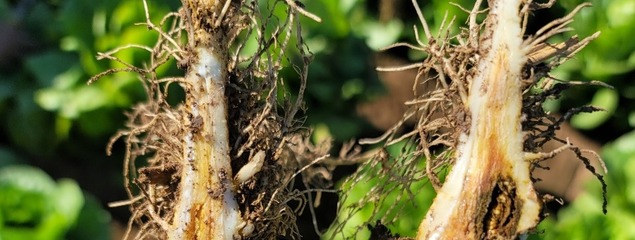
Plant Disease Management
Fusarium Wilt of Lettuce
Management Practices
Cultural Control
Cultural control of the disease begins with the prevention of field infestation. As the pathogen is not readily airborne, the spread of the disease is through spreading contaminated soil or contaminated seed. To prevent spread, all soil should be removed from field equipment once the equipment leaves fields known to harbor the pathogen. In addition, seeds should be tested for contamination if produced in areas where the pathogen is known to occur. Since the fungus lives indefinitely on decayed organic debris, all residue from previous crops should be either tilled into the soil or removed from the production areas.
Once a field is infested, the pathogen will persist for many years. Recent studies have shown that soil population levels can be reduced with either extended flooding during summer fallow or with extended periods of dry fallow. The disease appears to be more severe during the warmer early fall planting in contrast to the cooler early winter planting. Therefore, if a suspected contaminated field is considered for planting, seeding should be delayed until cooler early winter temperatures become established.
Chemical Control
Although the fungus appears to be sensitive to many broad-spectrum fungicides in the laboratory, these products have limited efficacy in the field. This is most likely due to difficulty in getting the product to the root zone at an effective concentration. Recent studies with plant defense activators have shown moderate success and continued work with these products is promising.
Biological Control
There are a number of biological control agents that have been shown to be effective against a wide range of fungal species, such as strains of the fungus Trichoderma and strains of the bacterium Bacillus. In greenhouse studies, several strains of the mycoparasitic fungus Trichoderma and the bacterium Streptomyces consistently reduced the impact of the disease. In addition, the use of a non-pathogenic strain of Fusarium oxysporum also had significant effects on the expression of the disease. However, in field trials under production conditions, the efficacy in suppressing Fusarium wilt in lettuce with these products singly or in combination has not been demonstrated to any substantial level.

